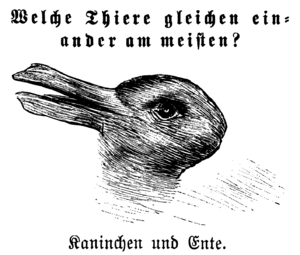Rabbit–duck illusion facts for kids
The rabbit–duck illusion is a famous picture that can look like two different animals: a rabbit or a duck! It's a great example of an ambiguous image, which means it can be seen in more than one way. Your brain might switch between seeing the rabbit and the duck, or you might see one more easily than the other.
How Did the Rabbit-Duck Illusion Start?
The very first time this drawing appeared was in a German humor magazine called Fliegende Blätter. This was on October 23, 1892. The picture had a question with it: "Welche Thiere gleichen einander am meisten?" This means "Which animals are most like each other?" Below the drawing, it said "Kaninchen und Ente", which means "Rabbit and Duck".
Why Is This Illusion Important?
A smart person named Joseph Jastrow, who studied how our minds work, used this picture. He showed how our brains can switch between seeing two different things in the same image.
Later, a famous thinker named Ludwig Wittgenstein made the picture even more well-known. He put it in his book Philosophical Investigations. He used the rabbit-duck illusion to explain two ways we "see" things. Sometimes we just "see that" something is there. Other times, we "see as" something, meaning we interpret it in a certain way. For example, you might "see that" it's a drawing, but then you "see it as" a rabbit, or "see it as" a duck. It shows how our minds can change how we understand what we look at.
See also
 In Spanish: Ilusión pato-conejo para niños
In Spanish: Ilusión pato-conejo para niños


